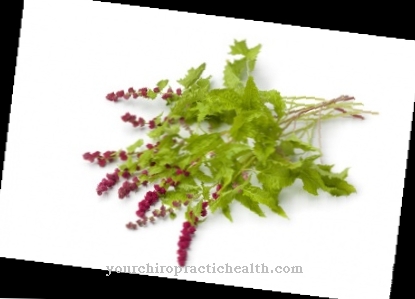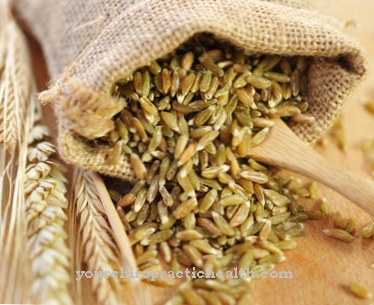The Grape is the fruit of the grapevine, which is one of the oldest useful plants of mankind. The climbing plant, which originally comes from the Caucasus and Mesopotamia, is now cultivated in numerous cultivated forms worldwide in all regions with a temperate or subtropical climate. Grapes are eaten raw, but also processed into various other products, some of which can also be used for medicinal purposes.
What you should know about grapes

As a grape or briefly grape the fruit cluster of the grapevine is called. It consists of a large number of individual grapes that grow on a panicle.
During the ripening period, grapes not only store water, but also the sugar produced by the plant through photosynthesis. As a result, the grapes usually taste pleasantly sweet. Grapes were already cultivated in prehistoric times and the grapes were modified through breeding. The first evidence of viticulture can be found from around 5000 BC. in the southern Caucasus region. Starting from Mesopotamia, viticulture first spread throughout the Middle East and from 1700 BC. in the Mediterranean. Viticulture reached today's France even before the Roman conquest, after which the cultivation of grapes became common in all parts of the Roman Empire that were suitable for this.
Nowadays, grapes are grown in numerous regions around the world. In the course of the history of viticulture, around 50 subspecies with a large number of varieties have emerged, which differ not only in terms of their adaptation to the growing region and the color of the grapes, but also in terms of taste and suitability for various purposes. Usually a distinction is made between table grapes and wine grapes. Table grapes are grapes that are eaten as fruit. Thanks to breeding, there are now also seedless table grapes. Wine grapes, on the other hand, are used for the production of grape juice and wine.
The berries of wine grapes are usually much smaller and thicker than those of table grapes. There are also grapes that are especially suitable for the production of raisins, as well as various types of rootstock onto which the noble vines are grafted. All grapes have a similar growth pattern, ranging from flowering in spring to ripening in summer to harvesting in autumn. Since grapes are now grown in various countries around the world and traded worldwide, table grapes are available almost all year round.
Importance to health
Although the grape tastes quite sweet compared to other types of fruit, it is very healthy. It is almost fat-free and therefore rather low in calories despite the fructose it contains. In addition, it has a quickly filling effect due to the high proportion of liquid.
The dietary fiber contained in the berry skins and grape seeds stimulate digestion, and the high potassium content has a dehydrating effect. This makes grapes ideal for fasting cures and weight reduction diets. A regular grape cure, which includes only eating grapes and drinking tea or mineral water for a day or two, can stimulate kidney and bladder function and help maintain body weight. The substances contained in the skins and seeds of grapes have a positive effect on blood circulation, so that the heart and circulation are strengthened.
This is especially true for red grapes and is even the case if the grapes are not eaten raw, but have been processed into grape juice or wine. In addition, the substances contained in grapes can regulate the cholesterol level, increase the absorption of vitamins and counteract harmful free radicals. This prevents cell damage, promotes cell renewal and slows down the aging process in the body. Grapes also contain substances that can inhibit the activity of harmful bacteria in the mouth. By reducing dental plaque, eating grapes can therefore reduce the risk of tooth decay.
Ingredients & nutritional values
| Nutritional information | Amount per 100 gram |
| Calories 67 | Fat content 0.4 g |
| cholesterol 0 mg | sodium 2 mg |
| potassium 191 mg | carbohydrates 17 g |
| protein 0.6 g | Fiber 0.9 g |
Grapes contain more fructose than many other types of fruit, but almost no fat and hardly any protein. With an average calorific value of almost 70 calories per 100 grams, they can therefore also be consumed in larger quantities without any problems. In addition to numerous minerals such as potassium, magnesium, phosphorus, iron and zinc, grapes also contain many vitamins, especially from the vitamin B group.
Proanthocyanides and the natural polyphenyl resveratol, which are considered excellent antioxidants and have been shown to have an inhibitory effect on cancer cells, are found in the skins of the grape berries and in the grape seeds. Red grapes have a significantly higher content of these substances than white, which is why red wine is also considered health-promoting when consumed in moderation. In a particularly concentrated form, however, they are mainly found in grape seed oil.
Intolerances & allergies
Because of the fructose it contains, people with fructose intolerance may experience digestive discomfort and other symptoms after consuming grapes. Abdominal pain, gas and diarrhea are particularly common in this case.
In rare cases, there are also allergic reactions to grapes. A grape allergy manifests itself as a tingling or burning sensation in the mouth area and in worse cases in the form of swelling and difficulty breathing. Usually, however, grapes are light and easily digestible food that is very digestible even for small children.
Shopping & kitchen tips
When buying grapes, care should be taken to ensure that the fruit is fresh and fully ripe, as grapes do not ripen after harvest. This can be recognized by firm and visibly plump berries. These should be undamaged, otherwise mold spores and vinegar bacteria can multiply quickly.
Since strong pesticides are still used in conventional viticulture, it is advisable to buy unsprayed grapes from organic cultivation for direct consumption. Nevertheless, they should of course be washed off under running water before eating. A dull whitish layer on the grape berries is not a sign of pesticides or spoilage. It arises naturally during ripening. Since grapes can only be stored to a limited extent, they should be consumed as quickly as possible. However, they can be kept for a few days in the fruit compartment of the refrigerator.
Preparation tips
Fresh grapes are usually consumed raw. They can also be used as toppings for cakes or as an ingredient in muesli or processed into jelly or jam. With the help of a juicer, fresh grape juice can also be obtained from grapes very easily at home.
Of course, this can also be bought ready-made, as well as a large selection of wines. Both juice and wine can be drunk straight, but can also be used for cooking. Other products such as brandy and vinegar, which can be used in a variety of ways, are also based on wine. Grape seed oil is also very versatile. It is tasteless and highly heatable and is therefore suitable for salads as well as for roasting.


























